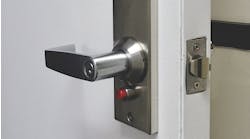Strategies for Success: School Security/Life Safety and Access Control (with related video)
Unwanted visitors intruding upon a school campus can be merely an annoyance or, as numerous events have shown, it can be the first step in an event that leads to violence and tragedy.
The focus on keeping unwanted visitors from entering school and university facilities has made school security at building entrances and exits a priority. Technological solutions, such as electronic access-control systems, intercoms and video monitoring enable education institutions to more effectively monitor who comes and goes in their facilities.
Traditional locks and keys may not provide the level of school security desired for a building. Keys can be lost, stolen or copied, and soon find their way into the hands of troublemakers. Changing locks because of lost keys can be expensive.
Improvements in technology have made electronic access control feasible for many institutions. Such a system, typically using a proximity card or a fob, has several advantages: It enables a school to track who entered a building and when; it can provide different levels of access to different personnel; it can alter the amount of access depending on the time of day or week; it can quickly deactivate lost access cards, detect when someone is trying to gain access with an unauthorized card and provide replacement cards easily.
Education facilities are required to keep doors to the outside unlocked so that those in the building can exit easily in case of an emergency. At the same time, schools want to keep those doors locked from the outside so that unwanted visitors cannot enter the building undetected. With electronic access control, doors can be locked to outsiders and monitored effectively from a central location. The system can detect when someone is trying to tamper with an exterior door or if a door stays open too long.
To prevent someone from using a chain to lock a school door and preventing those inside from exiting, doors to the outside should have their older panic bar exit hardware replaced with flush push bar hardware that cannot be chained.
On many college campuses, access-control cards have been incorporated into a more comprehensive campus card that in addition to providing access to residence halls and other campus facilities, serves as a debit card and library card.
If a school decides to have its entrance doors locked and the central office does not have a clear view of those seeking to enter, an intercom or a video camera can be used so that office personnel can determine whether a visitor should be allowed into the building. Many campuses have visitor badging systems that provide temporary identification for those who have been authorized to be in the school.
Some institutions use biometrics—finger, hand or eyeball scanning, for instance—instead of or in addition to access cards. Those methods may provide a higher level of security, but may draw objections from parents or community members who feel such steps infringe on their privacy.
A guide from the Clearinghouse for Educational Facilities, "School Security Technologies," cautions education institutions about assuming that a technology-based security system will solve all of a school’s safety problems.
"Before resorting to high-tech security solutions, school officials should think carefully about the potential for unintended consequences," the paper says.
Rather than become enamored of a technological solution that doesn’t really meet the security needs that an institution faces, facility managers should make sure they identify and prioritize safety problems before seeking a solution.
Related Video
News report on biometric use at Visitation School, Kensington, Pa.


